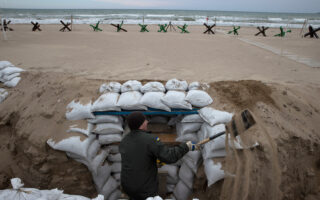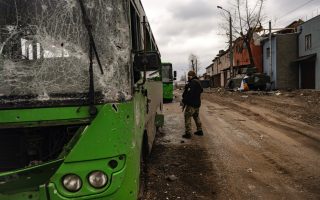Mariupol mass evacuation falters as Red Cross judges it too dangerous

The most ambitious effort yet to evacuate desperate civilians from Ukraine’s devastated port of Mariupol, besieged by Russian forces for weeks, was upended by disruptions Friday, with thousands of residents managing to flee but many more still stuck after the Red Cross judged the exodus too dangerous.
The suspended Red Cross evacuation in Mariupol, a city that has come to symbolize the horrors of the war in Ukraine, was among several developments painting a mixed picture Friday as one of the biggest armed conflicts to convulse Europe in decades rumbled into its sixth week.
New signs emerged that Russian forces, stymied by their own botched planning and fierce Ukrainian resistance, were retreating from areas outside of Kyiv, the capital, and moving north. Ukrainians asserted that they had retaken control of more than two dozen suburban towns and hamlets.
Ukrainian helicopter gunships struck an oil terminal inside Russia, Russian officials said – which, if confirmed, would be the first known Ukrainian airstrike in Russian territory since the Feb. 24 invasion.
Such an attack would be both embarrassing and potentially provocative to President Vladimir Putin of Russia in his troubled military campaign to subjugate Ukraine. Ukrainian officials gave conflicting accounts on whether Ukraine was responsible.
And in Chernobyl, the toxic defunct nuclear site in northwest Ukraine, which Russia seized in the war’s early days, Russian vehicles apparently stirred up radiation dust as they departed, the United Nations’ top nuclear official said. Whether Russian soldiers or others there suffered radiation poisoning remained unclear.
There had been some early optimism that an organized large-scale evacuation of Mariupol – a thriving port of 450,000 that has been all but obliterated by Russian shelling and bombs – could be undertaken Friday under the auspices of the Red Cross, after Russia’s Defense Ministry approved a temporary cease-fire.
Many thousands of civilians have been trapped in the city for weeks under constant Russian bombardment with limited access to food, water and electricity. Previous attempts at humanitarian pauses in fighting have repeatedly collapsed.
By some estimates, three-quarters of Mariupol’s population has fled, and about 100,000 people remain.
A team from the Red Cross that had been en route to Mariupol Friday to escort out buses and cars carrying civilians had to turn back because it was not guaranteed conditions to ensure safe passage, the organization said in a statement. It said the team, made up of three vehicles and nine personnel, would try again Saturday.
“For the operation to succeed, it is critical that the parties respect the agreements and provide the necessary conditions and security guarantees,” the Red Cross statement said.
The Red Cross had expected about 54 buses, along with an unknown number of private vehicles, to take part in an evacuation convoy carrying thousands of people.
While the larger convoy failed Friday, smaller groups of people have been able to leave the city in cars, according to local officials. On Friday afternoon, Iryna Vereshchuk, the deputy prime minister, confirmed in a statement on her Telegram page that a corridor had opened for private transport from Mariupol to the city of Zaporizhzhia.
Around noon Friday, Pyotr Andryuschenko, the Mariupol mayor’s adviser, said that some buses had left for nearby Berdyansk.
By day’s end, it remained unclear exactly how many people from Mariupol had been able to leave. But Kyrylo Tymoshenko, a top aide to President Volodymyr Zelenskyy of Ukraine, said on his Telegram account that roughly 3,000 people had managed to escape Friday and that more than 3,000 had been evacuated from other cities.
The Russians signaled a week ago that they might be pulling forces back from Kyiv and other areas in northern Ukraine and recalibrating their aims in the war, as it became increasingly clear that their military was performing poorly and Kremlin expectations of a quick victory were wrong.
Western officials and analysts were initially skeptical, suspecting the Russians were simply repositioning and resupplying for new attacks. While that may still be true, the Russian pullback from the Kyiv area after more than a week of Ukrainian counterattacks appeared to be real, the officials and analysts said, based on Ukrainian military accounts of retaken towns and other signs, including social media videos and satellite images, pointing to a Russian retreat.
“The counterattacks probably prompted the Russian decision to give up on Kyiv,” said Frederick W. Kagan, a military expert with the American Enterprise Institute in Washington. “The counterattacks demonstrated that the Russians were actually not going to be able to hold the positions they occupied anyway.”
The early morning helicopter assault on Russian territory took place in Belgorod, part of a staging area for the Russian invasion about 20 miles from the eastern Ukrainian border. Ukraine’s military previously had managed to hit Russian territory only with ground-launched missiles, and Russia had boasted that the Ukrainian Air Force had been “practically destroyed” in Russian assaults.
Video posted to VKontakte, a Russian social media site, and verified by The New York Times showed two helicopters firing at the oil depot on the eastern edge of the city. Although it was not possible to determine the nationality of the aircraft, the footage confirmed that an airstrike caused a fire at the site. Other video of the aftermath showed the depot burning well into the daylight hours.
Ukrainian officials were initially evasive about whether Ukraine’s forces had carried out the assault, but a top security aide, Oleksiy Danilov, issued what amounted to a denial by saying, “This does not correspond with reality.”
Whether or how Russia intended to respond remained unclear late Friday, but the attack did not appear to bode well for diplomacy to halt the war. Russia’s deputy permanent representative at the United Nations, Dmitry Polyanskiy, told reporters that such attacks “reflect the real intentions of the Ukrainian side and real intentions toward peace talks.”
Concerns about possible radiation exposure from the Russian seizure of Ukraine’s Chernobyl nuclear plant, where a 1986 meltdown caused the worst radiation accident in history, surfaced again Friday in remarks by Rafael Mariano Grossi, head of the International Atomic Energy Agency, the U.N. nuclear monitor. The Russians took control of the Chernobyl area last month and withdrew this week.
While Grossi said during a news conference at the agency’s headquarters in Vienna that radiation levels had not changed at the plant, he said heavy military vehicles had stirred up contaminated ground when Russian forces first invaded the area, “and apparently this might have been the case again on the way out.”
Grossi said that he was aware of reports that some Russian military personnel had been poisoned by radiation while they held the Chernobyl plant but that the subject had not been discussed during talks he held in Russia with nuclear officials.
“We heard about the possibility of some personnel being contaminated, but we do not have any confirmation,” he said.
Outside Ukraine, nations that have sought to penalize Russia by banning purchases of Russian oil took further steps Friday to help insulate themselves from the economic shock of higher oil prices caused by the reduced supply.
The International Energy Agency, a 31-member group of oil-consuming nations, said they had agreed to a new release of emergency oil reserves in what is turning into a historic, wide-reaching effort to calm global markets.
The move came a day after the Biden administration announced a 180-million-barrel release over six months from the strategic reserve held by the United States.
This article originally appeared in The New York Times.






